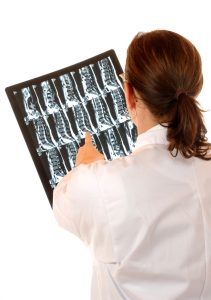Scoliosis (curvature back), is often diagnosed young
The non-medical term for Scoliosis is ‘curvy back’, making its effects known right away. In patients with Scoliosis the spinal column is curved laterally and in many cases also rotated around its axis. In the US, roughly 3 million new cases of the condition are diagnosed each year. The majority of new cases are identified as idiopathic scoliosis. Idiopathic scoliosis is a type of scoliosis that presents itself in children between the ages of 10 and 15. About the same number of girls and boys are diagnosed. However, curves in girls are 10 times more likely to get worse and may need to be treated.
What is scoliosis exactly?
If you look at the front or back to the spine, it is usually in a straight line. In normal posture, four natural curves can be observed from the side. These curves exist from the pelvis and the buttocks, in the lower back, in the middle back and in the neck. These S curves are needed to divide the body weight as efficiently as possible, and keep the body well balanced. As a result, minimal muscle strength is required to maintain the balance.
In scoliosis, however, the vertebral column is also curved laterally, causing one or two turns. The spinal column can also rotates around the axis causing a hump to develop. In C-shaped scoliosis, the spinal column develops only on one side. However, an S-shaped scoliosis occurs most commonly. There are then two lateral curves present. Scoliosis is defined when the curve is 12 degrees or more.
How does scoliosis develop?
Scoliosis may be present at birth, or it may not be detected until the teen years. The condition is then caused by one or more congenital vertebral abnormalities. The vertebrae may be incomplete, or fail to divide properly causing them to be stuck together. In most cases, scoliosis develops during the growth process from baby to teen. Girls are more likely to have severe curvature than boys. Cases are most often identified during growth spurts.
Scoliosis may also occur at an older age. In many cases, a difference in leg length plays a role. The body adjusts to accommodate the difference, which may result in a lateral position of the vertebral column. In addition, scoliosis can be the result of the aging process. Due to wear – and sometimes also under the influence of osteoporosis – an already present bend can increase in degrees. This form of scoliosis develops between the age of 40 and 50.
What are the symptoms of scoliosis?
The onset of scoliosis includes signs like uneven shoulders or hips. In advanced and severe cases of scoliosis one of the symptoms in this disorder is back pain. You will feel this pain most when bending forward. A curved chest may cause problems with blood circulation and respiration. If the spine curvature is present at a lower level, gastric acid may enter the gastrointestinal tract through the esophagus by pressure on the stomach. Other symptoms may be: headache, radiating pain to the legs, stiffness and fatigue due to decreased lung function.
How is scoliosis diagnosed?
In teens scoliosis usually detected during routine physical exams. During the exam the doctor will conduct a comprehensive physical examination. The vertebral column will be thoroughly examined from top to bottom. The doctor will inspect the shoulders, looking to see if they are skewed relative to each other. He will also look for any visible curvatures in the spine, or the presence of a hump. An X-ray can be used to check for lateral turns of the spinal column. When a Scoliosis has been diagnosed, the physician will determine whether treatment is required.
How is scoliosis treated?
Treatment is more effective the earlier scoliosis is detected. In addition, the main goal is to stop further lateral curving of the vertebral column. If this curvature is not more than 25 degrees, your doctor may suggest exercise therapy. This includes physical therapy, as well as Caesar therapy and mensendieck. These exercise therapies have a similar goal: reduce the pain and improve the flexibility of the back. In addition, the help of the chiropractor can be invoked, which focuses on the locomotion apparatus. In young patients who are still growing, or older patients with a curvature between 25 and 45 degrees, a brace may be recommended. While scoliosis will not fully disappear, the curvature can be stopped, slowed or reduced.
When is a surgical procedure performed to treat scoliosis?
In extreme cases, for example when the curvature exceeds 45 degrees, the brace loses its effectiveness. Sometimes surgery may be an option, however this is only needed in about 10% of cases. The doctor will recommend surgery sooner and more often for children than in adults. When done early, the surgery tends to be more simple, as less work needs to be done. The ability of children to heal quickly also plays a role. The spinal column in adults is stiffer and heals more slowly. During such surgery, the orthopedic surgeon may fuse portions of the spine, which prevents further curly growth.

Share this page
Tweet

Download for free the booklet ‘Moving without pain’ with a retail value of $6.75 / £4.95.
Any questions? Please feel free to contact us. Contact us







